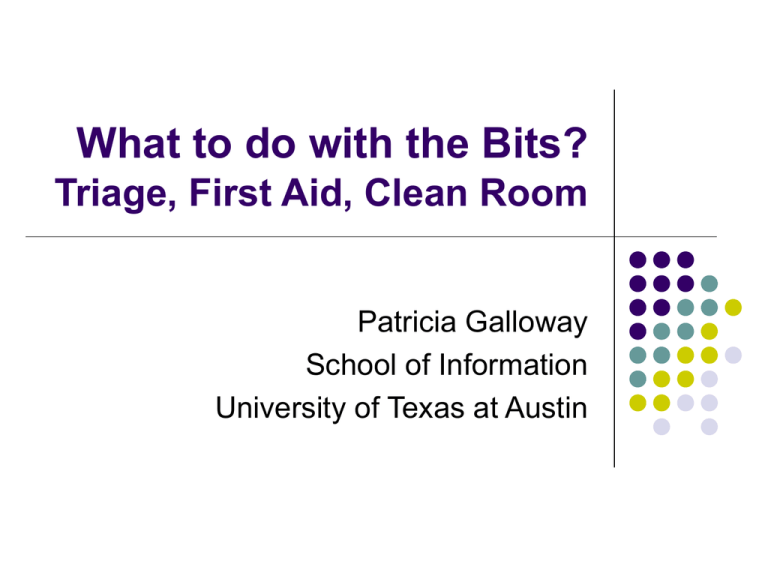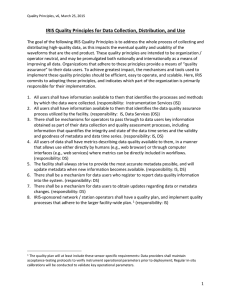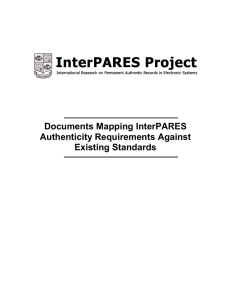What to do with the Bits? Triage, First Aid, Clean Room
advertisement

What to do with the Bits? Triage, First Aid, Clean Room Patricia Galloway School of Information University of Texas at Austin First step: DO NOTHING Digital records are harder to destroy completely than most believe But it is very easy to alter them and thus destroy their authenticity Hence: you must proceed forensically Ideas from digital discovery/digital forensics Archives CSI! First step: look but don’t touch What do you have? Inventory Find media and computers in collection(s) Note any evidence from original order Categorize and date them based on physical evidence Media names and formatting as proclaimed on media Timeline: http://en.wikipedia.org/wiki/Floppy_disk Labels on the media, even multiple ones (should you peel them off?) How does it fit? Context What are your working hypotheses? Who created? (evidence from the fonds) When? (scope note?) How does it compare in amount to paper? How might it be relevant? What is the computing history of the fonds creator? Construct a technology timeline (cf. Maria Esteva’s discoveries) Triage How old/outdated is it? How important is it? Does it likely have a paper counterpart? Will that counterpart maintain affordances? Might the digital amplify evidence? How much will it cost to retrieve? How much needs to be retrieved? Do you need to know what’s there before you can decide? First aid: What can you find out without killing the patient? Media format + operating system + application software = accessibility BUT Media format + operating system + application software = potential danger to authenticity Mining a digital fonds without reading it (MPLP?) Without opening any file you can potentially see: File arrangement Detailed directory listing File naming conventions But how to do it without risk? How can you find out? Do you have drives to read media? Do you have software to read/render/list the contents? Can you do this nondestructively? Does it matter? Are the materials well-documented and already an intentional copy? Do you need to recover process as well as content? If you don’t know, assume it does matter Authenticity warning 1 Creation date is crucial to archival interest Creation date may appear in many forms Metadata as part of file Metadata as auxiliary file (Mac resource fork) Metadata as managed by OS Creation date as managed by the OS may be changed systematically On copy On saving an opened file Authenticity warning 2 Creator/author metadata Placed by software Usually haphazardly set up by individuals May not reflect individuals if set up by company Cheap and cheerful: checking out floppies Apply hardware write-protect Try to read the medium If no adverse message “Do you want to format this disk?” “Disk is unreadable” Then copy to another medium Using forensic-copy software: maintains metadata Using your OS dates and other metadata will be altered Metadata must be captured before copy And set original aside Clean room procedure Digital environments can eat their young Alteration of metadata Alteration of format Neutral “clean room” environment needed: where object is seen ONLY as sequence of bits Tools for nondestructive copy out of original and into clean room: digital discovery Tools for nondestructive analysis of file system: digital forensics Is this the future? What do we really know about paper, after all? What tools do we use to decide how valuable it is? What can we know about digital objects if we are careful? What tools can we use to decide how valuable it is? Compare in terms of MPLP Paper: settle for high-level aggregate knowledge Digital: organize at will, mine out subjects, locate every item





